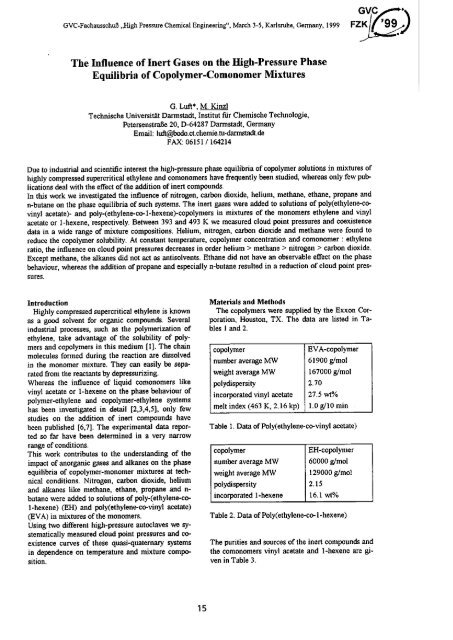March 3 - 5,1999, Karlsruhe, Germany - FZK
March 3 - 5,1999, Karlsruhe, Germany - FZK
March 3 - 5,1999, Karlsruhe, Germany - FZK
You also want an ePaper? Increase the reach of your titles
YUMPU automatically turns print PDFs into web optimized ePapers that Google loves.
GVC GVC^*+\<br />
GVC-Fachausschuß „High Pressure Chemical Engineering", <strong>March</strong> 3-5, <strong>Karlsruhe</strong>, <strong>Germany</strong>, <strong>1999</strong> <strong>FZK</strong><br />
: K j r 99^)<br />
The Influence of Inert Gases on the High-Pressure Phase<br />
Equilibria of Copolymer-Comonomer Mixtures<br />
G. Luft*, M. Kinzl<br />
Technische Universität Darmstadt, Institut fur Chemische Technologie,<br />
Petersenstraße 20, D-64287 Darmstadt, <strong>Germany</strong><br />
Email: luft@bc methane > nitrogen > carbon dioxide.<br />
Except methane, the alkanes did not act as antisolvents. Ethane did not have an observable effect on the phase<br />
behaviour, whereas the addition of propane and especially n-butane resulted in a reduction of cloud point pressures.<br />
Introduction<br />
Highly compressed supercritical ethylene is known<br />
as a good solvent for organic compounds. Several<br />
industrial processes, such as the polymerization of<br />
ethylene, take advantage of the solubility of polymers<br />
and copolymers in this medium [1]. The chain<br />
molecules formed during the reaction are dissolved<br />
in the monomer mixture. They can easily be separated<br />
from the reactants by depressurizing.<br />
Whereas the influence of liquid comonomers like<br />
vinyl acetate or 1-hexene on the phase behaviour of<br />
polymer-ethylene and copolymer-ethylene systems<br />
has been investigated in detail [2,3,4,5], only few<br />
studies on the addition of inert compounds have<br />
been published [6,7]. The experimental data reported<br />
so far have been determined in a very narrow<br />
range of conditions.<br />
This work contributes to the understanding of the<br />
impact of anorganic gases and alkanes on the phase<br />
equilibria of copolymer-monomer mixtures at technical<br />
conditions. Nitrogen, carbon dioxide, helium<br />
and alkanes like methane, ethane, propane and nbutane<br />
were added to solutions of poly-(ethylene-co-<br />
1-hexene) (EH) and poly(ethylene-co-vinyl acetate)<br />
(EVA) in mixtures of the monomers.<br />
Using two different high-pressure autoclaves we systematically<br />
measured cloud point pressures and coexistence<br />
curves of these quasi-quaternary systems<br />
in dependence on temperature and mixture composition.<br />
15<br />
Materials and Methods<br />
The copolymers were supplied by the Exxon Corporation,<br />
Houston, TX. The data are listed in Tables<br />
1 and 2.<br />
copolymer<br />
number average MW<br />
weight average MW<br />
polydispersity<br />
incorporated vinyl acetate<br />
melt index (463 K, 2.16 kp)<br />
EVA-copolymer<br />
61900 g/mol<br />
167000 g/mol<br />
2.70<br />
27.5 wt%<br />
l.Og/lOmin<br />
Table 1. Data of Poly(ethylene-co-vinyl acetate)<br />
copolymer<br />
number average MW<br />
weight average MW<br />
polydispersity<br />
incorporated 1-hexene<br />
EH-copolymer<br />
60000 g/mol<br />
129000 g/mol<br />
2.15<br />
16.1 wt%<br />
Table 2. Data of Poly(ethylene-co-1-hexene)<br />
The purities and sources of the inert compounds and<br />
the comonomers vinyl acetate and 1-hexene are given<br />
in Table 3.












![{A1[]Sp - Bibliothek](https://img.yumpu.com/21908054/1/184x260/a1sp-bibliothek.jpg?quality=85)




